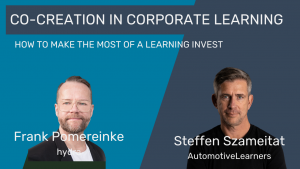Reading time: 12 minutes
Consumer trends have transformed how we learn. With Meta and Apple unveiling new consumer products that have overcome certain teething difficulties, VR is on the cusp of widespread use, exiting the domain of safety training.
To learn more about the technology, current and future use cases, and lingering limits, I chatted with Thijs de Vries, Warp VR’s co-founder and CEO, in the Netherlands.

A great question to start a conversation in this industry is always: What is your dream car, Thijs?
Thijs de Vries: That is a good question. On the top of the list would be a Land Rover Defender. I like the old model, but I also like the newest model, which is completely revamped. Really the kind of adventure, the ability to go to places where few people have been. I do not own one. I do own a couple of Lego models of Defenders. So that is the next best thing.
Very iconic.
Thijs de Vries: This is distinctive in its shape and looks. The need is absolutely a second thing because I live in a city and only drive on asphalt. I do not really need a Defender, obviously. Therefore, it might be a dream car.
Thijs, you are the CEO of Warp VR. Since when you were in this industry, in this technology?
Thijs de Vries: We started with two other co-founders back in 2017. That is also my first introduction to VR as a technology. I saw the potential of this technology. My background is learning, gaming, and using gamification to change behaviour. I did that as an entrepreneur before starting this venture.
But then I came across VR as a technology, especially that combination between learning, changing behaviour, applying gaming techniques, and VR as a technology. Which is just a means to an end, since it is about the learning goal, engagement, what people learn, and how they learn. But there was immense potential for using that technology in combination with that kind of learning.
2017 was early for VR.
VR was eventually born in the 1960s, with massive headsets, from an R&D perspective.
2017 was the first time it had the potential to truly become a consumer device. There were a few headsets back in the day that could have had the potential to become consumer devices, such as the Oculus Rift, for instance. But you also had, on the other side, the Samsung Gear VR, which is a way cheaper device.
A lot has happened in the last six, seven years. A lot of new and different devices came to the market, leading to way more adoption by consumers of these VR headsets.

What is the impact of VR on the learning space?
Thijs de Vries: In terms of technology, it really changed and evolved over the last six, seven years. Devices became better, faster, and of better quality. Eventually, that led to the ability for more people to enjoy VR.
Six, seven years ago, you had to be a technical wizard to use these devices. Also, if you put on a VR headset, you are closed off from the surrounding environment. So, you are on your own. You needed a little bit of conviction to start using this technology.
That has completely changed because it is now easy to use. Sometimes, even without controllers, you can just use it for hand tracking.
The user experience has been improved quite a bit. Meta is doing well providing an operating system for the Quest headsets. That is the headset they sell on the market. They are super easy to use. So, you can see that it is becoming more of a mass consumer product.
It is still an evolving market. Yesterday, Apple announced that the Apple Vision Pro is coming to the market on February 2. That is a new player on the market. Apple is doing things in a certain way with a high user experience and high quality, initially an expensive product. But it will bring the whole quality and user experience of VR to a higher level. And that will impact learning and the training industry as well.
Let’s double click here. In the past, learning involved studying or going to school, followed by relaxation. We continue to use the two-hour training session idea for corporate training. However, in the recent past, blended learning has become more prevalent in the course of employment. Do your use cases already include these use cases?
Thijs de Vries: As WarpVR, we help clients with VR training. We have a platform, an authoring solution, where clients can build their own VR training scenarios and have them played by their employees.
The use cases are typically in the health and safety area, for instance, evacuations, CPR (cardiopulmonary resuscitation), fire drills, and safety procedures in the workplace. But we are also seeing soft skills and customer service training, client conversations, leadership, even public speaking, addressing teams. In all these use cases, VR helps by giving the feeling of presence in these scenarios.
In the conventional way of learning, we tell people a lot, we send information, classroom sessions, for instance, and then eventually we test whether that knowledge that we presented is there with the learner. So, we talk and then we test.
If you look at games, and this is what changed in learning philosophy in the last ten years, you can also do it the other way around. So, yes, you can test at the end whether the knowledge is there, but you can also directly start testing. because the test is already a way of learning.
When you play a game, let’s say a mobile game, it would be a completely boring game if I explained to you how it works. You want to try and find out for yourself.
You want to fail because it makes it hard. It makes it difficult, but it makes it reachable. These levels are always designed in such a way that they are hard to reach, but always possible. It always feels like it is possible. This way, you keep on going.
Gaming eventually is learning. You learn how to play the game; you learn tactics. Once you have learned those tactics, you can apply them in real life. And that philosophy, combined with VR, is a strong one.
OK, you can apply new knowledge to a situation, For instance, in a sales pitch with a potential client,. And on the other hand, you can discover these tactics in a gamified environment where you can test things without breaking stuff.
Thijs de Vries: Absolutely. You enter a virtual world where it is safe, and, if a fire drill occurs, it will not cost anything when the building is destroyed. VR does make it possible to get as close to reality as possible.
And by doing that, it also evokes emotions. When something happens—a fire, let me say, that is quite scary, right? You want to be as close to that emotion as possible to learn the best procedure to find the exit, for instance. What would happen in real life when that emotion kicked in? And you can recall that procedure because you have been there before, you have already experienced it, and you experienced it in a safe way. It is better to recollect and apply that knowledge in real life.
I talked to a fighter pilot about training in safety procedures, and he said, when push comes to shove and the pilot is losing control,. They instruct their students to sit on their hands for 10 seconds. Because of the rush of adrenaline, they make the wrong decisions. Is there a way to simulate that rush of adrenaline in VR training?
Thijs de Vries: Absolutely. And this is a fitting example. Whatever happens in VR training is that rush. You want to get as close to that rush as possible.
Let me give you an example of a training course that a client of ours did, which was a bank robbery.
This is a bank in Austria, and by law, it is required for branch employees of these banks to be trained for bank robbery. That still happens. So, they have that training for bank robbery. So, they decided to train in VR. They did it with actors before. But the emotion of a bank robbery did not really come through with the actors because you are there with your colleagues, you are all at headquarters. It has a completely different vibe from an actual bank robbery.
So, you want to get as close as possible to that emotion. So, they did it in VR. We helped them with the production of that training scenario. And that rush is really what happens there, when somebody enters the bank holding a gun and demands to hand over the money.
There is a rush. You might make a decision that is not in your favour or in the favour of other people in the bank. So, that ten-second rule is good. But then, in the simulated environment, it is no problem if you make a wrong decision.
It might be good that you make a wrong decision because you can experience its consequences. And the thing is, after you made that wrong decision,. You know, somebody died. Something bad happens. You just try again. You play again, and you start the scenario from the first scene. You go through it again, and you do that a couple of times. And, that repetition makes the fact that the rush will be less whenever such an event really happens. And maybe then the 10s are just one second.
So yes, obviously, there’s always that emotional pressure involved in making snap decisions in these high impact situations. But you can make them more rational, less emotional if you train them in a realistic setting and go past that emotion.
That is what VR can do. And especially with that gaming context. That is what we are doing together with our clients.
What are the challenges to getting the most value out of VR based training?
Thijs de Vries: There are challenges, but in the last few years, we have seen fewer and fewer challenges.
In the beginning, people had difficulty operating these VR headsets, even getting motion sickness. But it became easier to start using VR.
Still, there are challenges. Looking at the clients that we have, hardware is still a challenge. Not so much the cost of hardware because the current price of these VR headsets is not a lot. It is often difficult to calculate the potential return on investment. If you have employees that are trained well for these safety procedures, but still, companies buy 100 headsets or a thousand and not 20,000 or 50,000. These headsets are all shared VR headsets, meaning that it can still be difficult to get your hands on a headset as an employee.
The second is also content. Eventually, if you train employees in safety procedures or even customer service, the training content is often very custom to the client. They have their procedure, they have their product, and they have their safety procedure. Some of them can be off-the-shelf, but most of them are custom.
And that requires time and resources to create that content. With platforms such as ours, we make it easier for clients to create this.
Our clients typically have learning and development functions. They have already created e-learnings. So now they can also create VR training, which is a bit of a unique way of working. But that is what we explain to them how that works. Getting them into the VR mindset. But it does require a certain amount of time and effort to create that high-quality and engaging content.
Also, the last thing to add is that this is less and less an issue around safety and guidance. So not everybody is familiar yet with VR. Although most people have had VR experience before,. Putting on a headset does require a certain amount of trust, because you are enclosing yourself in the actual environment. You are kind of there by yourself. Often, these experiences can be social, but they can be daunting at first. Having that guidance by trainers or experts for employees, especially for first time users, is especially important for overall success.
AI (Artificial Intelligence) is the trend that we observe currently. How is it impacting VR? Is AI bringing the cost down, for example, for content development?
Thijs de Vries: AI is bringing the cost down. It is affecting so many industries and so many technologies. VR is one of them.
We already see what generative AI can do, not only when it comes to text, but also when it comes to images. And now, when it comes to video, for instance, but also 3D assets. So generative AI can help in lowering the barrier to creating content, so it can speed up content development, whether it is figuring out the storyline of a certain training, creating the actual video, for a training, or eventually creating the 3D assets for training.
Development time can be reduced with AI. With less time required to build these training scenarios. And what we are also seeing right now is that certain training experiences have a component of a personalised approach where, in a soft skills training, for instance, you can talk to an avatar, which is an AI avatar, and then the avatar responds. Because AI is producing the response in real time, it can always be different. That can also increase the replayability of these training scenarios because they can be different every time you play them. Which is especially the case for these soft skill scenarios.
Do we reach a point sometime near the point of singularity for VR, meaning that the training in the classroom does not exist anymore without some aspects of VR?
Thijs de Vries: I would say no. That would be the better future.
I believe in a blended approach. People learn in different ways. They have different learning styles. VR is a powerful format. But when it comes to, let’s say, learning equations for math, VR is not the best way of doing that.
There is always this requirement for diverse ways of learning. There will always be a human component required to eventually train humans. So,
VR will be big, and it will become a lot bigger than it currently is. But it will always be that blended approach, which currently includes e-learning, classrooms, workshops, and VR.
Thijs, the automotive industry is going through a change process. If you had the chance to send a message to the CEOs of the automotive industry, what would your message be?
Thijs de Vries: An interesting question. Especially because the automotive industry has been one of the first industries where technologies such as VR have been applied. In the design and development of new cars, employee training, engineering, maintenance, etc.
What is interesting is that the car is a product, but eventually you buy an experience. In many cases, you buy an experience because the brand represents a certain experience. And the car is the product that solidifies that experience.
VR is also an experience: you put on a headset, and you are in this experience.
Brand experience is a huge component when it comes to selling.
Also, looking at self-driving cars, that is going to be super interesting, too.
The people in the car are going to do something different than what they are currently doing. They are not driving anymore. For in-car entertainment or the experience in the car. I can totally imagine that car headsets can pop out of the roof, which you can put on and be already at work for any kind of work application. Or it is more gaming- or entertainment related.
The car is going to take you from A to B, but meanwhile, you experience something completely different. That is a remarkably interesting future.


